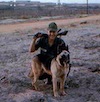720th Military Police Battalion Vietnam History Project |
|
|

|
Your historical contributions and comments are always welcomed and appreciated on this website. To eliminate duplication of materials and information, the 212th MP Company (Sentry Dog) Long Binh Post Detachment pages have been incorporated into this company timeline page. Specific activities relative to it are identified with- HQ Long Binh or Long Binh Detachment-P. In addition, all page links, linked photographs and their Email links have been reformatted and updated. The same process, with the exception of some dated photographs (most will still be maintained in their respective detachment pages), has been done with the textual timeline history of all the other 212th company detachments. If you have any questions about this process please feel free to direct them to the History Project and Website Manager via the Email Link at the top of this page. |
1967 |
January |
At the start of the year the company still retained the distinction of being the only Army Sentry Dog Company in South Vietnam, and with the continuing buildup of U.S. combat arms, air and logistics support units, they quickly began to feel mission strain. The restrictions of their Table of Organization and Equipment (TO&E) severely limited 89th MP Group from expanding the company's detachment missions. |
21 January The M-16 rifles requested by company headquarters through Brigade on 19 September 1966 were issued. |
23 January The company headquarters and supply sections vacated Shea Compound, and moved to the Pershing Field Military Police Compound, Tan Son Nhut Airbase, Saigon without disruption of its operations. |
Exact Date Unknown The 18th MP Brigade reported that during the previous two months surveys were conducted to determine the feasibility of sentry dog utilization at the maintenance depot area at Plekiu, and the MACV facilities compound at Hue/Phu Bai. At the time of the survey both were found unsuitable for sentry dog use, however further inspection of their status would be monitored and considered. |
February |
4 February, Long Binh Post Detachment-P The Viet Cong once again created havoc in the 3rd Ordnance Battalion Ammunition Supply Depot on Long Binh Post when a group of pads containing over 15,000 high explosive 155mm artillery projectiles were destroyed. |
Personal Reflections “While we were at our ambush point outside the perimeter they blew up 22 pads of ammunition in one of the other areas of the 3rd Ordinance Ammunition Supply Depot. We had to retreat and take cover under the jeep at the rear of our ambush point to avoid the falling shrapnel. I will never forget this because it happened on my birthday. My family told me this attack was covered in the news media due to the amount of ammo pads that were blown up. |
If I remember correctly, Battalion [S2 Intelligence & Security] investigated this and found that the local Vietnamese that were hired to unload the ammo from the trucks planted satchel charges in it and that’s what blew up the ammo pads." PFC James Hogan, C Company, 720th MP Battalion, October 1966-November 1967. |
Company Headquarters Moving To Long Binh Post |
Long Binh was commonly referred to as LBJ, for "Long Binh Junction," which is really what it was to start with in 1965 and early 1966. An undistinguished area of rice paddies, orchards and rubber trees where several main roadways met just a few miles to the east of Bien Hoa City. Later the acronym LBJ (Long Binh Jail) would become the nickname for the USARV Stockade. The first detachment billets and kennels were tents, which eventually gave way to wooden framed structures. The tall trees in the area provided much needed shade from the relentless heat and sun. Not long after the wooden buildings began to be replaced. |
March |
With the continuing buildup and expansion at Long Binh Post to lessen the U.S. Army footprint in Saigon, GEN Westmoreland ordered a move of many of the combat arms and support units under Military Assistance Command Vietnam's (MACV) Operation MOOSE (Move Out Of Saigon Expeditiously). As a result of a more permanent footprint being established at Long Binh Post, the older canvas and wooden structures used as billets, offices and kennels were being replaced with new aluminum framed Adam's Huts. They were cooler, not subject to termites and rot, had cement floors, and presented much less of a fire hazard. Weekly reports on the construction status of each company’s Adam's Huts, were reported by the battalion to the 89th MP Group. |
10 March, Long Binh Detachment-P MG W. D. Rossen, Chief of Staff, MACV conducted an inspection of the repairs and security upgrades and adjustments made at the 3rd Ordnance Ammunition Supply Depot since the 4 February Viet Cong attack of the installation. Upon completion of the inspection, MG Rossen briefed GEN William C. Westmoreland, Commanding General, MACV; the briefing was laudatory of the installations and security components efforts and progress in making the requested changes. HQ, 3rd Ordnance Battalion, HQ 1st Logistical Command [Long Binh Post] provided operational control, while company provided interior perimeter security with sentry dog handler teams, and watchtower staffing was provided by D Company, 52nd Infantry [95th MP Battalion], with exterior security outside the perimeter provided by a platoon of ambush teams from C Company, 720th MP Battalion. |
12 March In a letter from GEN Westmoreland to the Deputy Commanding General of MACV in regards to the 10 March inspection of the 3rd Ordnance Ammunition Supply Depot, he praised the progress achieved at the depot to date, and requested his remarks be forwarded to the subordinate commands involved. |
30 March MG C. W. Eifler Commanding, HQ, 1st Logistical Command, forwarded GEN Westmoreland’s commendatory remarks about the progress with the upgrades at the 3rd Ordnance Ammunition Supply Depot to HQ, 18th MP Brigade, along with his complementary comments to the brigades subordinate units that were involved, ie. 95th MP Battalion: D Company, 52nd Infantry, 720th MP Battalion: Charlie Company and 212th MP Company (Sentry Dog). MG Eifler stated that, “Your immediate response to the requirements of this command [USARV] proved that the combat Military Policeman is always prepared to provide timely and effective assistance under any circumstances. Especially noteworthy was the efficient and highly professional performance of duty by members of the 720th MP Battalion, Company D, 52nd Infantry [95th MP Battalion], and the 212th MP Company (SD). I wish to express my appreciation and congratulations to appropriate members of your command for a job well done." |
April |
30 April, HQ Long Binh Detachment The company along with the 89th MP Group, 16th MP Group, 8th MP Group (CI) underwent an announced Headquarters S2 18th MP Brigade semiannual counterintelligence inspection during the preceding months. The inspections covered classified documents control, accountability procedures, personnel security, storage facilities and security procedures. Except for minor administrative errors all units were reported as having no deficiencies or violations. |
Under instructions of the Headquarters, 18th MP Brigade, a total of ten sentry dog utilization surveys were conducted during the preceding three months to determine the feasibility of future sentry dog team deployment and to evaluate their effectiveness in the following locations:
|
. |
1- Base Camp of the 2nd Brigade, 9th Infantry Division at Dong Tam. |
2- Base Camp of the 3rd Brigade, 9th Infantry Division at Tan An. |
3- Two Ammunition Supply Depots at Qui Nhon. |
4- Vung Chau Mountain Signal Site at Qui Nhon. |
5- Camp McDermott Logistical Supply Area at Nha Trang |
6- [reevaluation] 3rd Ordnance Ammunition Supply Depot at Long Binh Post. |
7- Sub Area Command Logistical Supply Area and Ammunition Supply Depot at An Khe. |
| 8- Ammunition Supply Depot at Tuy Hoa. |
| 9- Ammunition Supply Depot and Logistical Supply Base at Cam Rhan Bay. |
During the same period the Headquarters, 18th MP Brigade submitted a complete unit history of the company to the Department Of The Army, Washington, D.C. Submitted a request recommending the company be awarded the Meritorious Unit Commendation based upon its past service in the Republic of Vietnam. Made arrangements with the 3rd Region TMA to airlift all sentry dogs, handlers, and dog food by special mission to prevent the previously experienced delays of shipping by regular cargo methods. Announced that approval was received for delivery of ten AN/PRT-4 and AN/PRR-9 radios for the company handlers operations. Reviewed a deployment concept plan submitted by the company for future planning purposes in the event another sentry dog company was to deploy to the theater. Reviewed plans submitted by the company upon a directive from G-3 USARV, for a cantonment large enough to house the company headquarters personnel, sentry dog kennels and sanitation facility in anticipation of a future move [Operation MOOSE] to Long Binh Post. |
At the end of the month the company headquarters was stationed at the Pershing Field Military Police Compound at Tan Sin Nhut Airbase in Saigon, and was staffing handler teams at the following detachments:
|
. |
Detachment A, Pleiku. |
Detachment B, Qui Nhon. |
Detachment C at Ban Me Thuot. |
Detachment F at Vung Tau. |
Detachment J at Da Lat. |
Detachment L at Soc Trang. |
Detachment M at Vinh Long. |
| Detachment O at An Khe. |
| Detachment P at Long Binh Post. |
| Detachment R at Nha Trang. |
| Detachment T at Phan Rang. |
May |
Exact Date Unknown, HQ Long Binh Detachment CPT Short passed command of the company to CPT James Riley. Before he departed on 25 May, CPT Short issued a Letter of Appreciation to all the troops. During the month the 18th MP Brigade was conducting operational manpower surveys and determined there was a need for another scout dog unit. Plans were put into motion to meet the operational need. |
11 May The Headquarters, 18th MP Brigade announced to the company headquarters that the tentative utilization plan for the 981st MP Company (Sentry Dog) scheduled to arrive in-country in October would be put into operation, and the 981st will assume sentry dog security at all II Corps Tactical Zone posts now served by detachments of the company. All company detachment assets from II CTZ will then be reassigned to security duties in the III & IV Corps Tactical Zones. |
June |
1 June 1967-29 January 1968 |
HQ Long Binh Detachment CPT James Riley assumed command of the company, and twelve man-dog teams participated in the Brigade change of command ceremony held on Long Binh Post. |
10 June, Nha Trang Detachment The company detachment supporting the 5th Special Forces Compound at Nha Trang in Khan Hoa Province, III Corps Tactical Zone, was phased out due to improvements in the physical security of the compound. |
. |
32nd Medical Depot Detachment Two of the handler teams returned to Headquarters Detachment were reassigned to the 32nd Medical Supply Depot (44th Medical Brigade) on Long Binh Post in Bien Hoa Province, III Corps Tactical Zone on a temporary basis for the support of the 1st Logistical Command. |
. |
The 32nd Medical Depot subordinate to Headquarters 44th Medical Brigade, Saigon was singularly responsible for the medical supply support of the U.S. Army and Free World Forces, Vietnam. In addition, they furnished medical supply support in accordance with Interservice Support Agreements to the U.S. Navy in II, III and IV Corps Tactical Zones and other U.S. Agencies. As with any Army logistical supplies and inventory in Vietnam, all fell under the umbrella of Headquarters, 1st Logistics Command. |
. |
A new depot was being constructed and upon its completion, the 32nd was scheduled to move its stock of supplies and equipment from the Saigon Docks to Long Binh Post. The transport of the unit’s supplies and equipment was carried out from 20 July through 2 August. |
. |
The currently available quarterly reports of the 89th MP Group and 18th MP Brigade did not specify the handler team’s walking posts, or the date the temporary security mission was finally terminated. |
Tay Ninh Detachment Approval was received to form Detachment “I” that would become operational on 10 August and assigned to the Tay Ninh Ammunition Supply Depot. |
July |
Exact Date Unknown, HQ Long Binh, Ban Me Thuot, & Phan Rang Detachments The issuance of the ten AN/PRT-4 (transmitter set) and AN/PRR-9 (receiving set) radios for the company handlers was initially delayed due to crystal problems. Once the issue was corrected twenty-five of the sets were immediately issued to the company on a trial and test basis in the detachments at Long Binh Post, Ban Me Thuot and Phan Rang. Initial comments on the radios were favorable, and the company was instructed to submit periodic reports on their operation to the Brigade S3. |
The handler teams reported problems in handling their M-16 rifles in addition to their required basic load, radio and sentry dog. The primary problem was the sling wasn’t long enough. |
To correct the problem each handler was issued a second sling to extend the length of the original sling allowing the rifle to be slung diagonally over the body thus allowing the handler to use both his hands for using the radio and still maintaining control of his K9. The extended sling also acted as a support when firing the rifle with one hand, which the handler may desire to do it the situation dictates that his K9 should not be released. |
It was suggested by company headquarters that a more desirable weapon would be the CAR-15 (Sub-machinegun) carried by all Air Force Sentry Dog handlers. Brigade submitted a request through higher headquarters for the issuance of the CAR-15 to the company. |
The problem of contaminated Prime Brand dog food arriving from General Food’s factories infested with Red Flour Beetles continued. The 44th Medical Brigade’s canine care unit and 1st Logistical Command were continuously addressing the problem by inspecting all arriving shipments, testing and destroying by burning those found to be contaminated and storing the uncontaminated shipments in areas that have been disinfected. General Food’s was notified of the problem, which occurs state-side before the product is shipped. |
31 July COL Thomas F. Guidera passed command of the 18th MP Brigade to BG Harley L. Moore, Jr. The ceremony was conducted at the 643rd Engineer Motor Pool on Long Binh Post. Representative of each brigade subordinate command, including the 212th were present with their colors. VIP’s in attendance were LG Bruce Palmer, Jr. Deputy Commander USARV, MG Carl C. Turner, Provost Marshal General and BG Thinh, Deputy Commander, ARVN III Corps. During the preceding three months the company completed sentry dog utilization surveys to determine the feasibility of future sentry dog handler team employment, and to evaluate their effectiveness in the following locations throughout the Corps Tactical Zones:. |
. |
32nd Medical Depot on Long Binh Post. |
62nd Maintenance Battalion in Pleiku. |
Dong Ba Thin Airfield Facilities. |
Phu Heip 268th Combat Aviation Battalion. |
Tay Ninh Ammunition Supply Depot. |
Pleiku Camp Holloway Ammunition Supply Depot. |
A total of 117 man-dog teams were received and processed at the company headquarters in the Pershing Field MP Complex, Tan Son Nhut Airfield, Saigon. Upon completion of processing the teams were shipped to the operational detachments. |
The company was still located at Pershing Field and staffing detachments at he following locations. Some of the detachments letter prefixes had been changed since previous reports. |
. |
1- Headquarters Detachment at Pershing Field in Gia Dinh Province, III CTZ. |
2- A Detachment at Pleiku in Pleiku Province, II CTZ. |
3- B Detachment at Qui Nhon in Binh Dinh Province, II CTZ. |
4- C Detachment at Ban Me Thuot in Darlac Province, II CTZ. |
5- F Detachment at Vung Tau in Phuoc Tuy Province, III CTZ. |
6- J Detachment at Da Lat in Tuyen Duc Province, II CTZ. |
| 7- L Detachment at Soc Trang in Ba Xuyen Province, IV CTZ. |
| 8- M Detachment at Vinh Long in Vinh Long Province, IV CTZ. |
| 9- O Detachment at An Khe in Binh Dinh Province, II CTZ. |
| 10- P Detachment at Long Binh Post in Bien Hoa Province, III CTZ. |
| 11- T Detachment at Phan Rang in Ninh Thuan Province, II CTZ. |
The previous company detachments at Nha Trang (Khanh Hoa Province, II CTZ) and Can Tho (Phong Dinh Province, IV CTZ) no longer appeared on the 18th MP Brigade organizational list for the company, and there was no information as to why. |
August |
13 August A message from the 14th ICC to U.S. Army Mobility Equipment Center (USAMEC) was sent requesting that all new shipments of Prime Brand dog food be shipped at thirty-day intervals, not in larger quantities, believing that until the Red Beetle issue can be addressed at General Food’s, the lower stockage levels of dog food would reduce the spoilage rate. Further recommendations were to wrap future shipments in multi-wall insect material or utilize tin containers. The problem was also brought to the attention of Army Material Command (AMC) for immediate review and corrective solution. |
September |
Exact Date Unknown, HQ Detachment Under the command of CPT James Reily the 212th moved its 1st Platoon and Headquarters from the Pershing Field Military Police Compound in Saigon, Capital Military District, Gia Dinh Province, III Corps Tactical Zone to Long Binh Post, Bien Hoa Province, III Corps Tactical Zone. The 1st Platoon and HQ consisted of approximately 90 men. Personal Reflection "During that period in 1967 the company consisted of approximately 230 men and 190 K-9’s, all German Shepherds. Of that number a special squad of Scout Dog Teams was developed consisting of five specially trained handlers and K-9’s. They also had eight Veterinary Technicians and one was assigned to each detachment. Serious cases of K-9 illness or injuries wre sent to Saigon. |
The company Table of Organization & Equipment (TO&E) consisted of four, 1/4 ton trucks [jeeps], and three, 3/4 ton trucks and trailers. Each platoon headquarters unit was assigned 1 jeep and 1 truck and trailer, the fourth jeep was assigned to the company commander. Their weaponry at the time was .45 caliber side arms and M-16 rifles, there were no crew served weapons. |
The company maintained a total of eight detachments, two in the north in I & II Corps and six in the south in III & IV Corps. The number of teams for staffing at each detachment depended on the mission. A team consisted of one handler and one K9. The III Corps Detachments were, 1st Platoon & Company HQ, approximately ninety men, at Long Binh Post with a squad detachment at Bearcat. The Long Binh Post assignments were perimeter security at the 3rd Ordnance Ammunition Depot, and Scout Dog Unit to assist the 720th MP Battalion counterinsurgency - pacification mission in their Tactical Area of Responsibility (TAOR). |
. |
The Bearcat Detachment provided perimeter security at the ammunition storage depot and airfield. 2nd Platoon Headquarters at Vung Tau, with a squad detachment at Tay Ninh. The Vung Tau and Tay Ninh Detachments provided perimeter security at the respective ammunition depot areas. IV Corps, 3rd Platoon Headquarters at Vinh Long with a squad detachment at Soc Trang. Both provided perimeter security at the respective airfields. There were also two detachments in the northern Corps." CPT James T. Roberts, Jr. (COL Ret.) Commanding Officer, 212th MP Company, 95th & 720th MP Battalion's, 89th MP Group, 18th MP Brigade, November 1967 to June 1968. |
Editor's Notes: Information on these detachments is pending further research. If you can provide any information, documentation, personal stories or photographs, use the Email Link at the top of this page. |
Area of Operations change with arrival of the 981st MP Company (Sentry Dog) |
October |
Exact Date Unknown The 981st MP Company (Sentry Dog) arrived in South Vietnam and was assigned to the operational control of the 16th MP Group, 18th MP Brigade. Their mission was to provide sentry dog coverage in II Corps Tactical Zone. |
. |
With their arrival, the company displaced their sentry dog detachments in II Corps Tactical Zone, which now became the area of operations for the 981st, freeing up manpower and assets for additional missions in III & IV Corps Tactical Zones. |
The company was reorganized to three platoons of two sections each. A section was assigned to a particular military installation. |
. |
Each section had a varying number of dog teams depending on the needs of the supported installation mission. The first platoon was the largest in that it supported the Ordnance Battalion at the Long Binh Ammunition Depot and the scout dog mission in support of the 720th MP Battalion. |
. |
First Platoon: Long Binh ammunition storage and TAOR operations, Tay Ninh ammunition depot.
|
Second Platoon: Bearcat ammunition storage, Vung Tau ammunition and storage areas.
|
Third Platoon: Vinh Long US Army airfield, Soc Trang US Army airfield).
|
There were six veterinary technicians assigned backed up by a supporting medical brigade veterinary clinic in Saigon.
|
. |
Each platoon headquarters had one one-quarter ton truck (platoon leaders jeep) and one three-quarter ton truck for working dog team posting (local garrisons supplied vehicle support at some locations. |
The individual working dog team was composed of a handler and his dog. The handler was armed with a .45 cal. semi-automatic pistol and an M-16 rifle. For communications purposes, he carried a helmet mounted squad radio that worked sporadically. Each team was deployed after the evening meal and a detailed guard mount. |
. |
The posting sergeant or lieutenant would inspect each team for the following: weapons and ammunition operability and cleanliness, radio operability, helmet and fragmentation vest worn properly, multiple canteens full with clean water for man and dog, and full working dog kit that was clean and usable. He then would go over intelligence and other operational information. |
. |
The muzzled dogs and handlers would be then transported to their posts at dusk or after dark. The teams would generally work alone in those open spaces between manned towers or bunkers on the perimeter. |
. |
In summary, the Company was composed of about 180 men and officers, 200 dogs (sentry and scout), five 1/4-ton trucks (jeeps) and three 3/4-ton trucks. By the table of organization and equipment, the heaviest weapon was the M-16 rifle. |
November |
Exact Date Unknown CPT James Reily passed command of the company to CPT James T. Roberts, Jr. |
Personal Reflection “The third week of November 1967, I assumed command of the 212th MP Company, headquartered on the southern perimeter of the Long Binh Post. This was to be my second company command. The previous commander, Captain (later Colonel) James Riley, had just moved the headquarters and first platoon up from Tan Son Nhut airbase on the northwest outskirts of Saigon. |
. |
The 212th was in a unique position as it was an independent, one of a kind company that reported directly to Colonel Frank Payne commanding the 89th MP Group. |
. |
This move was made upon the completion of permanent dog kennels, veterinary clinic and metal barracks on the southern portion of the military installation. The compound also had a water tower for sanitation of the two kennels, showers, a headquarters building, kennel master storerooms and company arms room. A chain link fence surrounded the working dog training area and gave us a second fence line to the barbed wire perimeter fence next to the southern perimeter road. |
. |
Across the road was a small hill [Hill-23] that overlooked the compound to the north and the tactical area of responsibility of the 720th MP Battalion to the south. One of my first acts was to go to the 89th MP Group commander and request that the hill be graded flat. The request was denied as the Vietnamese government indicated that the hill had religious significance [part of a Buddhist monastery grounds] and would not permit its destruction." CPT [COL Ret.] James T. Roberts, Jr. Commanding Officer, 212th MP Company, 89th MP Group, 18th MP Brigade, Vietnam, November 1967 to June 1968. |
. |
Editors Notes: During the New Years Tet Offensive of 1968 the enemy did not utilize the area because they attacked the post from the northwest. However, during the Post Tet New Years Offensive of 23 February 1969 the enemy attack was from the south and they occupied a ridge extension of Hill-23 as a strong point from which they ambushed a B Company ambush & recon squad assigned to sweep the area in the morning. Four MP's were wounded, one severely before the position was taken and 23 enemy were killed. The ridge was graded level within days after the battle. |
29 November, 1000 hours CPT Steven J. Vass, the new 720th MP Battalion S-3, chaired a meeting for all company officers and operations sergeants regarding the utilization of the new Scout Dog Teams being provided by the 212th MP Company (Sentry Dog). The meeting was to insure that all companies that had missions in the TAOR had a common understanding of how to request the teams, their capabilities and limitations, and protective measures to be taken when the dogs were tracking. The teams would prove to be a very valuable addition to the counterinsurgency mission. |
Personal Reflection “I was one of the two original scout dog handlers with the 212th at Long Binh. We received our dogs and trained with the 199th. Infantry Brigade [Camp Frenzell-Jones]. SP/4 Jim Kelly was the other handler. My scout dogs name was Prince, and we received our training in 1967 and we were both sentry dog handles at the Long Binh [3rd Ordnance] ammo dump prior to this. We did patrols throughout the Bien Hoa area and set up nighttime ambushes on a regular basis working with different platoons of the 720th.” SP/4 Roger W. Fauver, 212th MP Company (Sentry Dog), Scout Dog Unit, 95th & 720th MP Battalion's, 1967-1968. |
|
December |
Personal Reflection “During the month I had two priorities: build a tactical operations center (TOC) and visit all detachments. The above ground TOC was completed quickly and began after duty hour’s operations. Its main function was to maintain communications with the five working dog detachments, the 720th MP Battalion TOC and the 89th MP Group. |
. |
Made of reinforced timber and multiple sandbags, it could withstand small arms fire and near hits from a mortar attack. Little did we know that we would be using it in a number of days. |
. |
The officers at the company headquarters were executive officer 1LT Arnold L. Seligman (COL Ret.) an exceptionally calm, forward planning officer who ensured that the company was fully supported at all times, and 2LT Gary M. Freedman the 1st Platoon leader and the typical hard-charging officer who was eager to close with the enemy. He later went on to commanded the 188th MP Company that was responsible for convoy escort in the delta. Both supported the company in an outstanding manner. |
. |
The 2nd Platoon leader in Vung Tau was reassigned to Saigon soon after I arrived. 2LT Saricini was then assigned to the second platoon. The 3rd Platoon leader remained in Soc Trang. |
. |
After several days reviewing the company mission, I started visiting the outlying detachments. All of the soldiers lived in well-ventilated wooden tropical hutments. Their dogs were in concrete kennels with dog runs. All of the kennels were on a perimeter at an isolated position where exterior traffic was not annoying to the dog’s senses and to keep their psyches aggressive toward non-handler humans. CPT [COL Ret.] James T. Roberts, Jr. Commanding Officer, 212th MP Company, 89th MP Group, 18th MP Brigade, Vietnam, November 1967 to June 1968. |
Vinh Long Detachment |
Personal Reflection "The end of December found me in Vinh Long with SP/4 Danny Conyers, my driver and a third MP riding as shotgun. My mission was to persuade the airfield commander to allow our dog handlers to work the perimeter. The layout was that the garrison buildings were grouped next to the main national highway [Highway-4] with the helicopters and their revetments between the buildings and the airstrip. |
. |
The airstrip was for conventional aircraft and extended southward into the rice paddies and a swamp area. The above ground perimeter defense bunkers were at intervals around the landing strip and the entire complex. The working dog kennels were situated on the western perimeter near the main gate. |
. |
The lieutenant colonel commanding the airfield had a particular problem. The resident aviation units were constantly and clandestinely requisitioning parts from each other during the hours of darkness to maintain their aircraft for the next day’s missions. He was using the dog teams to walk the flight line in an effort to reduce thievery. I discussed the main reason for the deployment of dogs to his airfield: that of anti-infiltration security. |
. |
After my briefing on the capabilities of canines and, in particular, the negative effect of gas and oil fumes on the dog’s sense of smell, he indicated that he would not change his policy. Upon leaving with the detachment sergeant, we learned from AFN radio that General Westmoreland had rescinded the unilateral ceasefire truce order he had issued to U.S. Troops for the TET New Year celebration season. |
I took the hint. Things were about to happen if HQ MACV had made that decision. We were about fifty kilometers from Saigon and had to use the national Highway-4 that connected Vinh Long with Can Tho with Saigon to get back to Long Binh. Although it was in the afternoon, we felt we could get into Saigon before dusk. |
. |
The detachment sergeant and I discussed his needs and we left for the ferry crossing northwest of Vinh Long. At that point, I realized how vulnerable we were. We were the only U.S. military vehicle on the road, on the ferry, and beyond. SP/4 Conyers hit the gas as we drove off the crowded ferry. About half way to Can Tho, we were fired upon from a tree line as we left one of the small villages along the route. To make it more surreal, we drove through an ARVN armored attack that was crossing Highway-4. It was going from southeast to northwest. To our left beyond the far wood line, there was smoke rising from an air strike. From Can Tho north, to and through Saigon it was quiet with no visible activity.” CPT [COL Ret.] James T. Roberts, Jr. Commanding Officer, 212th MP Company, 89th MP Group, 18th MP Brigade, Vietnam, November 1967 to June 1968. |
1967 Miscellaneous Photographs |
A "?" following the photo number denotes further identifications are needed, and an Email Link is provided. |
Personnel & Facilities |
| Unidentified handler and K9 at the ammunition depot. | |
| Detachment sign. | |
| SP/4 James F. X. Gilmartin and his K9. | |
| Company HQ sign at Pershing Field. | |
| 1LT Dunlap & CPT Roberts at Orderly Room. |
Use Your Browser Button To Return
|

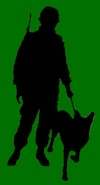

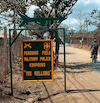

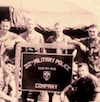
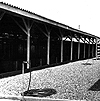
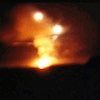
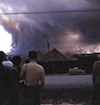
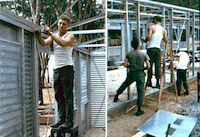
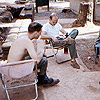
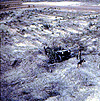




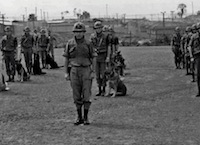
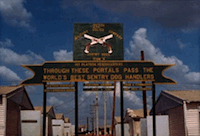
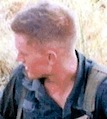 SP/4 Fauver
SP/4 Fauver